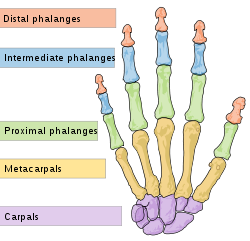- Intermediate phalanges
-
Intermediate phalanges are bones found in the limbs of most vertebrates. In humans, they are the bones of the finger and toe which lie in the middle, between the two wrinkly joints. The thumb and big toe do not have intermediate phalanges. In most other vertebrates, they have a corresponding place in their limbs, whether they be paw, wing, hoof or fin.
The intermediate phalanx is not only intermediate in location, but is also usually intermediate in size among the other phalanges ("finger" bones).
See also
- Bone terminology
- Terms for anatomical location
Bones of upper limbs (TA A02.4, GA 2.200–230) Pectoral girdle,
clavicleScapula fossae (subscapular, supraspinatous, infraspinatous) · scapular notch · glenoid cavity
tubercles (infraglenoid, supraglenoid) · spine of scapula · acromion · coracoid process
borders (superior, lateral/axillary, medial/vertebral) · angles (superior, inferior, lateral)Humerus upper extremity: necks (anatomical, surgical) · tubercles (greater, lesser) · intertubercular sulcus
body: radial sulcus · deltoid tuberosity
lower extremity: capitulum · trochlea · epicondyles (lateral, medial) · supracondylar ridges (lateral, medial) · fossae (radial, coronoid, olecranon)Forearm Hand carpus: scaphoid · lunate · triquetral · pisiform · trapezium · trapezoid · capitate · hamate (hamulus)
metacarpus: 1st metacarpal · 2nd · 3rd · 4th · 5th
phalanges of the hand: proximal · intermediate · distalCategories:- Bones of the upper limb
- Skeletal system
- Musculoskeletal system stubs
Wikimedia Foundation. 2010.

